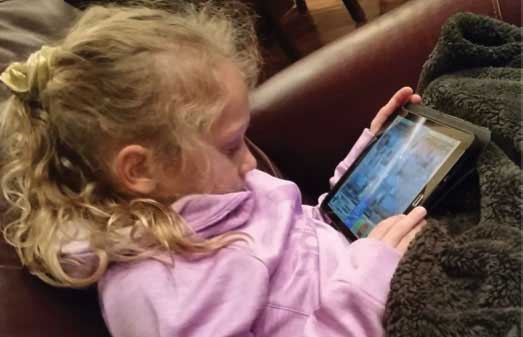 |
Myopes were found to spend more time on near activities, including device use, than their non-myopic peers. Photo: Julie Tyler, OD. |
Understanding the behavioral factors that contribute to myopia in children is an essential step toward slowing the condition’s upward trend in prevalence. With this in mind, a group of researchers recently examined a group of myopic children both subjectively using parental questionnaires and objectively using wearable sensors to obtain a more concrete picture of the visual environment of patients with and without the condition. Based on their findings, they concluded that myopic and non-myopic schoolchildren exhibit distinct behaviors; specifically, myopes had longer daily durations of near viewing and spent less time outdoors.
Of the 40 children (aged 10-18) included in the study results, 25 had myopia. Each child wore two sensors for one week: the first was a Clouclip, which objectively measures near viewing and light exposure from its position on the right temple of the spectacle frame, and the second was an Actiwatch, which measures sleep and activity levels and is worn around the wrist. Each parent filled out a questionnaire about their child’s daily time spent doing various activities and average sleep duration. Using both methods, the researchers then estimated the hours of near viewing for each child.
The average daily near viewing duration measured by the sensors was 6.9 hours. Not only did myopes spend more time daily in near viewing, but they also spent more time in intermediate viewing than non-myopes and had higher diopter hours. Children with myopia also had less daily light exposure and spent less time outside throughout the week. Behaviors that did not vary between myopic and non-myopic subjects included short- and long-duration near viewing episodes, electronic device use (12 hours a day on average) and sleep duration (8.2 hours per night on average).
The researchers noted that the significant device use reported among the cohort can likely be attributed to the fact that this study was conducted during the COVID-19 pandemic, when most of the children were attending school virtually. This may also be the reason for the low estimated time spent outdoors, which averaged just 24 minutes during the week and 54 minutes on weekends compared with a previous study that also used an Actiwatch for measurement and found that children spent approximately 72 minutes outdoors during a similar season.
“Myopic children spent approximately half as much time exposed to outdoor bright light compared with non-myopes on both weekdays and weekend days, as measured objectively with the Clouclip,” the researchers wrote. “Lower light exposure in myopic children, as observed here, may have an effect on myopia progression in already myopic children. Similarly, the very low light exposure experienced by non-myopic children, compared with previous studies carried out when there was not a pandemic, may result in increased myopia prevalence in the near future.”
The combination of an objective method of measurement with a subjective method is what the researchers said allowed them to more accurately review and determine distinctions in the visual environment of patients with myopia.
“Using objective wearable sensors, findings show that myopic children had longer daily near and intermediate (10cm to 100cm) viewing duration, lower light exposure and less time in high-intensity outdoor light (>1000 lux) compared with non-myopic children,” the researchers concluded.
Bhandari KR, Shukla D, Mirhajianmoghadam H, Ostrin LA. Objective measures of near viewing and light exposure in schoolchildren during COVID-19. Optom Vis Sci. December 21, 2021. [Epub ahead of print]. |

